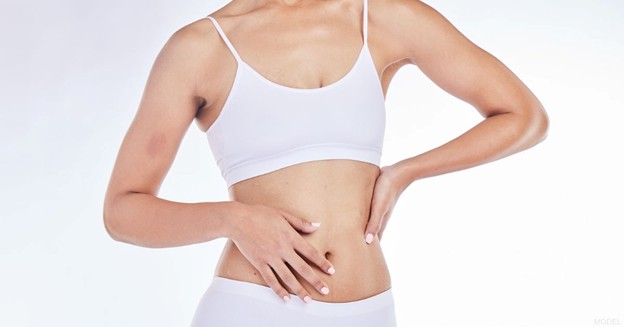People considering abdominoplasty are commonly concerned about scarring, often asking, “Will I have a noticeable scar after tummy tuck surgery?” We’ll answer that question directly: In the hands of an expert plastic surgeon with a proactive and robust recovery protocol, your tummy tuck scar will be as low, as short, and as discreet as possible.
How Big Is a Tummy Tuck Scar?
Most tummy tuck scars are horizontal and extend across the lower abdomen, typically from hip to hip. The length and position vary depending on how much skin needs to be removed, but here’s the key difference at Parker Center:
Before surgery, Dr. Parker will mark your incision under the line of your favorite underwear or swimsuit.
That means your scar is designed to stay hidden—even in revealing clothing. In many cases, the incision is also shorter than the one used in standard tummy tuck procedures performed elsewhere.
What Does Dr. Parker Do Differently?
Creating an attractive, low-profile scar is just one part of Dr. Parker’s surgical commitment to optimal scar healing. His signature approach includes:
- Precise, low-incision placement based on your unique anatomy and wardrobe
- Multiple layers of dissolvable sutures to minimize tension
- Internal quilting stitches to close space and support healing
- Dr. Parker himself performs all of your surgery, including inserting all of your sutures—he does not have this done by another surgeon, PA, or other personnel as is often done elsewhere
- Post-op silicone-based scar cream starting 3 weeks after surgery
These techniques are part of our Rapid Recovery Program, which also includes Exparel® or similar injections into the areas of muscle tightening for non-opioidal pain relief and lymphatic massage to support better healing. We also offer helpful tummy tuck recovery tips to support your healing.
What Does a Tummy Scar Look Like?
Tummy tuck scars begin as thin, raised lines darker than your skin tone, and they typically fade over the following 6 to 12 months. Many patients find that after 1 year, the scar is flat, pale, and barely noticeable.
Scar appearance varies slightly from person to person based on skin tone, genetics, and adherence to aftercare. Given the wide variety of patients with different genetic backgrounds that Dr. Parker treats, he has mastered incision closure techniques to optimize the healing of their incisions.
Scar Care Tips
Proper incision care is one of the most important ways to ensure your tummy tuck scar heals smoothly and fades well over time. At Parker Center, we provide detailed postoperative instructions tailored to your needs, but here are some general guidelines to keep in mind:
- Follow Dr. Parker’s instructions closely. Keeping your incision clean and dry, using the recommended scar cream, and avoiding unnecessary strain on your abdomen will support optimal healing.
- Protect your scar from the sun. UV exposure can darken scars permanently, so keep your incision covered and use sunscreen (SPF 30 or higher) once it’s fully healed.
- Stay hydrated and eat a nutritious diet. Your body needs proper hydration and nutrients to repair skin effectively.
- Don’t smoke or use nicotine products. They can compromise blood flow and slow the healing process.
With consistent care, your scar can become one of the smallest details of your transformation. Learn more about maintaining your outcome in our blog post on how long tummy tucks last.
Trust Experience—and Attention to Detail
From pre-op preparation to post-op support, our goal is to give you a smooth recovery, satisfying results, and peace of mind every step of the way. Get started on your body contouring today by requesting a consultation online or calling our office at (201) 967-1212.





Dr. Parker is the best! I had my abdominalplasty and umbiblical hernia 6 years ago by him. My scars came out great-smooth and flat. I still get compliments on how great my stomach and belly button look. I am 100% satisfied and would go back to him if I ever needed anything again. His staff is super nice and professional.
Thank you for your kind words, Susan!